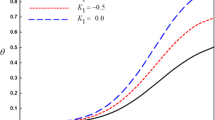Abstract
We consider a non-prismatic cylinder consisting of an anisotropic, compressible, inhomogeneous thermoelastic material, subject to either null tractions or null displacements on the lateral boundary and loaded by a self-equilibrated force system at one end. We show that the mean square cross-sectional measures of the temperature and the coupled displacement—temperature either grow faster than an exponentially increasing function of axial distance or decrease faster than a decaying exponential function of axial distance. We thus establish a Phragmèn-Lindelöf principle for the thermoelastic cylinder of variable cross-section.
Sommario
Viene considerato un cilindro non-prismatico costituito da un materiale termoelastico, anisotropo, comprimibile ed omogeneo. Il cilindro é soggetto a zero trazioni o zero dislocamenti sul limite laterale ed é caricato su uno dei termini con un sistema autoequilibrilata delle forze. Mostriamo che il valore medio quadratico della temperatura e dell'accoppiata della temperatura ed il dislocamento cresce più veloce che una funzione esponenziale crescente della distanza assiale o diminuisce più veloce che una funzione esponenziale declinante della distanza assiale. Viene stabilito un principio di Phragmèn-Lindelöf per il cilindro termoelastico di sezione trasversale variabile.
Similar content being viewed by others
References
Biollay, Y., ‘First boundary value problem in elasticity: bounds for the displacements and Saint-Venant's Principle’,ZAMP,31 (1980) 556–567.
Carlson, D. E., ‘The linear theory of elasticity’. in S. Flügge (ed.),Handbuch der Physik, Vol. VIa/2, Springer-Verlag, Berlin, 1972, pp. 297–345.
Gurtin, M. E., ‘The linear theory of elasticity’. in S. Flügge (ed.),Handbuch der Physik, Vol. VIa/2, Springer-Verlag, Berlin, 1972, pp. 1–295.
Flavin, J. N., Knops, R. J. and Payne, L. E., ‘Decay estimates for the constrained elastic cylinder of variable cross section’,Quart. Appl. Math.,47 (1989) 325–350.
Horgan, C. O., ‘Recent developments concerning Saint-Venant's Principle: an update’,Appl. Mech. Rev.,42 (1989) 295–303.
Horgan, C. O. and Knowles, J. K., ‘Recent developments concerning Saint-Venant's Principle’,Adv. Appl. Mech.,23 (1983) 179–269.
Horgan, C. O. and Payne, L. E., ‘Lower bounds for free membrane and related eigenvalues’,Schneider Memorial Volume, Rend. Mat. (7,10 (1990) 457–491.
Knops, R. J., ‘A Phragmèn-Lindelöf theorem for the free elastic cylinder’,Schneider Memorial Volume, Rend. Mat. (7,10 (1990) 601–622.
Kutler, J. R. and Sigillito, V. G., ‘Lower bounds for the Stekloff and free membrane eigenvalues’,SIAM Rev.,10 (1968) 368–370.
Toupin, R. A., ‘Saint-Venant's Principle’,Arch. Rat. Mech. Anal.,18 (1965) 83–96.
Author information
Authors and Affiliations
Rights and permissions
About this article
Cite this article
Lupoli, C. A Phragmèn-Lindelöf principle for the thermoelastic cylinder of variable cross-section. Meccanica 28, 315–322 (1993). https://doi.org/10.1007/BF00987168
Received:
Accepted:
Issue Date:
DOI: https://doi.org/10.1007/BF00987168




